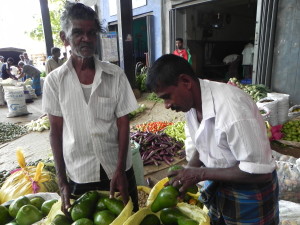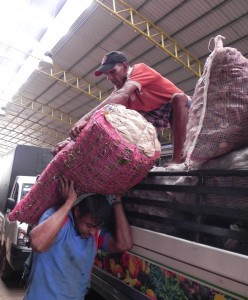
Text and photos by Renuka Jeya Raj
Shouts echo through the vast hangars as burly men, their sarongs tucked over bulging bellies, scurry hither and thither, urging the long line of trucks to get a move on to unload their precious cargo. Sinewy youth position themselves alongside the trucks as they come to a standstill, muscles rippling with the exertion of taking the weight of the heavy sacks placed on their shoulders. The sacks are then passed to willing hands that skilfully stack them into neat piles under the watchful eyes of the mudalalis of the various market stalls. Sack upon sack of succulent beets, freshly harvested leeks with the fragrant red earth still clinging to them, golden potatoes, juicy green gourds, creamy avocados are stacked as high as the eye can see. These sacks of freshly harvested produce will soon be ripped open and subjected to the careful scrutiny of buyers who will shake, tap and pinch them to assess their turgidity and freshness.
This is a typical day in the life of the Dambulla Economic Center, Sri Lanka’s largest wholesale market for fruit and vegetables, which comprises three vast hangars that resemble a domestic aerodrome from above. This is a market that never sleeps. It is geared to accept the newly harvested produce that arrives during the day from all over Sri Lanka, and accommodates the buyers who arrive at night to take their pick. Over 200,000 kg. – about 70% of the country’s requirement of fruit and vegetables – is processed here daily. Business at the market is affected by the vagaries in the prices of the produce. The Dambulla market is presently experiencing a substantial drop in prices of many high- value crops, which traders attribute to there being a glut in the market caused by over production in several parts of the country: often, all the farmers in a particular area either grow a single crop, or grow large quantities of a limited number of low- cost crops like carrots, tomatoes and beans, which results in the harvesting of more vegetables than meets demand and a consequent drop in prices.

This, added to the lack of adequate storage facilities, has in many instances, compelled farmers to destroy their harvests. This has caused them considerable losses and hardship. Market experts attribute this production surplus to the lack of a centralized plan for growing vegetables. A cohesive plan that controls production and advises farmers to grow vegetables in quantities that can be sold, is vital. Farmers need to be told how to diversify their crops or to stagger out cultivation. A systematic solution for selling the surplus elsewhere or exporting it, should also be explored.
It is perhaps a little known fact that this flourishing wholesale market owes its existence to a feeder canal that was tapped by encroachers to water home-grown produce. The Hurulu- Kandalama feeder canal was built in 1976 to increase the fast-dwindling flow of water into the dry zone tank, Hurulu wewa. This 22 mile long canal took off from the Bowatanne reservoir in the Central Province and passed through dense jungle to reach its destination in the North Central province. Encroachers from surrounding areas set up homesteads in these jungles and siphoned off the water with pipes. This water was used to grow high- value crops like chillies, big onions and vegetables, which found a ready market with the dense traffic plying the main Dambulla Road. At first, this produce was sold from make-shift kiosks built by the road-side, but these kiosks soon proved unable to contain the sheer volume grown. Then the state decided to lend a hand and in 1996, construction on the Dambulla wholesale market began.
Only about 45% of the water from the Bowatanne reservoir reached Hurulu wewa in the Maha season and about 22% reached the wewa during the Yala season due to the illegal tapping of the feeder canal. IWMI (then IIMI – International Irrigation Management Institute) was involved in the USAID-funded SCORE (Shared Control of Natural Resources) study that was set up in 1994 to research the Hurulu wewa watershed. “IIMI recommended regularizing these land entitlements within the Mahaweli system to prevent encroachers from occupying the land. This resulted in a much more efficient water management system. The substantial increase in the crops grown in these areas proves the success of our strategy,” says IWMI Researcher B. R. Ariyaratne, who had been involved in the SCOPE project.
Hurulu wewa is one of sixteen dry zone tanks built by Sri Lankan King Mahasena of the 1st century AD, to provide an assured supply of water for paddy and other dry zone crops. The tanks were constructed in cascades to ensure that the spillover of one tank flowed into the next, which minimized water wastage. The ingenuity of the tank system exemplifies the skill of the ancient Sri Lankan engineers and ranks among the finest work of its kind in the world to this day.
[hr top=”yes”/]
Renuka Jeya Raj is Communications Specialist/Writer at IWMI

